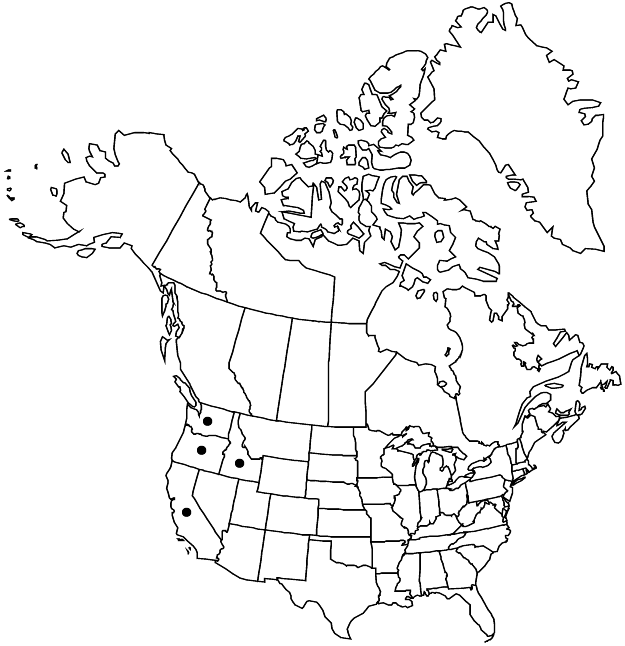Difference between revisions of "Aconogonon davisiae"
Preslia 46: 151. 1974.
FNA>Volume Importer |
imported>Volume Importer |
||
| Line 8: | Line 8: | ||
}} | }} | ||
|common_names=Davis’s knotweed | |common_names=Davis’s knotweed | ||
| + | |special_status={{Treatment/ID/Special_status | ||
| + | |code=E | ||
| + | |label=Endemic | ||
| + | }} | ||
|basionyms={{Treatment/ID/Basionym | |basionyms={{Treatment/ID/Basionym | ||
|name=Polygonum davisiae | |name=Polygonum davisiae | ||
| Line 34: | Line 38: | ||
-->{{Treatment/Body | -->{{Treatment/Body | ||
| − | |distribution= | + | |distribution=Calif.;Idaho;Oreg.;Wash. |
|discussion=<p>Varieties 2 (2 in the flora).</p><!-- | |discussion=<p>Varieties 2 (2 in the flora).</p><!-- | ||
--><p>The varieties are largely sympatric and often intergrade. The treatment here follows Hong S. P. (1991).</p> | --><p>The varieties are largely sympatric and often intergrade. The treatment here follows Hong S. P. (1991).</p> | ||
| Line 65: | Line 69: | ||
|basionyms=Polygonum davisiae | |basionyms=Polygonum davisiae | ||
|family=Polygonaceae | |family=Polygonaceae | ||
| − | |distribution= | + | |distribution=Calif.;Idaho;Oreg.;Wash. |
|reference=None | |reference=None | ||
|publication title=Preslia | |publication title=Preslia | ||
|publication year=1974 | |publication year=1974 | ||
| − | |special status= | + | |special status=Endemic |
| − | |source xml=https:// | + | |source xml=https://bibilujan@bitbucket.org/aafc-mbb/fna-data-curation.git/src/bb6b7e3a7de7d3b7888a1ad48c7fd8f5c722d8d6/coarse_grained_fna_xml/V5/V5_1221.xml |
|subfamily=Polygonaceae subfam. Polygonoideae | |subfamily=Polygonaceae subfam. Polygonoideae | ||
|genus=Aconogonon | |genus=Aconogonon | ||
Revision as of 23:30, 27 May 2020
Plants 12–42(–50) cm. Stems ascending to erect, glabrous or pubescent. Leaves: ocrea reddish brown, funnelform, 0.3–3 cm, margins oblique, glabrous or finely pubescent to pilose; petiole 0.3–10(–15) mm; blade oblong-ovate to ovate, rarely broadly lanceolate, 2.1–7.5(–9.5) × 1.1–5 cm, subcoriaceous, base truncate or, rarely, cordate, margins entire, glabrous or ciliate, apex obtuse to acute, faces often glaucous, glabrous or pubescent. Inflorescences axillary, racemelike; peduncle essentially absent. Pedicels 0.5–1.9(–2.4) mm. Flowers 1–4 per ocreate fascicle, rarely some flowers with stamens poorly developed; perianth greenish to pinkish white, 2–4.5 mm; tepals slightly dimorphic or, rarely, distinctly so, oblong-ovate to obovate, apex obtuse; anthers yellow or pink. Achenes exserted, yellowish brown, not beaked distally, 3.2–6(–8.3) × 2.1–5 mm, shiny, faces not concave. 2n = 20.
Distribution

Calif., Idaho, Oreg., Wash.
Discussion
Varieties 2 (2 in the flora).
The varieties are largely sympatric and often intergrade. The treatment here follows Hong S. P. (1991).
Selected References
None.
Key
| 1 | Faces of leaf blades pubescent, rarely glabrescent | Aconogonon davisiae var. davisiae |
| 1 | Faces of leaf blades glabrous | Aconogonon davisiae var. glabrum |